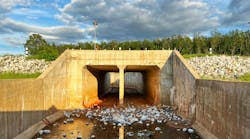IECA Control Factors: Eyes in the Sky
Unmanned aerial vehicles (UAVs), popularly referred to as “drones,” recently have become a hot topic of discussion. On a regular basis, media reports highlight UAV incidents involving privacy concerns and close encounters with passenger aircraft. What sometimes is not reported is how UAVs are revolutionizing the way some tasks can be performed. In the construction industry, these tools have the potential to provide high-resolution aerial imagery and remote sensing data that can assist inspectors in performing focused and strategic site inspections of erosion and sediment control practices in an efficient and effective manner. With increasingly stringent construction storm water regulations, inspections have become an integral component in ensuring adequate protection of our nation’s waterbodies.
Over the past couple of years, our research group at Auburn University has been using UAVs on construction sites to identify applications where the technology can be advantageous. The most direct benefits is capturing photos and videos from a bird’s-eye perspective. Aerial photos can provide an enhanced perspective that can give an enriched understanding of ground conditions. Runoff flow paths can be easily identified from rills and gullies scouring the terrain that inspectors can use to evaluate not only the extent and severity of the issue, but also the origin. Real-time streaming footage allows an inspector to efficiently identify areas of deficiencies on or off site that can be further investigated on foot if warranted. Advanced applications of post-processed data have the capability of generating useful material. For example, photogrammetric analysis can create 3-D orthomosaic models, useful for measuring lengths, areas and volume. These can be valuable for performing material quantity take-offs of required perimeter controls, discovering areas to seed or vegetate, and determining stockpile volumes of fill or spoil. Advanced sensors, such as infrared, multispectral and hyperspectral, are capable of identifying vegetative indices (plant health, established density, water and nutrient demands, etc.).
The most common question I receive is on the legal issues regarding the operation of UAVs. In February 2015, the Federal Aviation Administration (FAA) issued a notice of proposed regulations for commercial operation of small UAVs (under 55 lb). Proposed regulations will limit operation to a 500-ft ceiling and speeds to 100 mph, require operators to maintain visual contact with UAVs at all times and ban nighttime operation (none of which should hinder the use of UAVs for storm water inspections). Furthermore, operators will be required to pass a background check and an airspace knowledge exam. The agency planned to issue a ruling by September 2015; however, that is likely to be delayed. Until final regulations are issued, operators looking to use UAVs for commercial operation are required to hold a Certificate of Authorization (COA) from the FAA. Hobbyists operating non-commercially are not mandated to obtain a COA, but are required to stay below 700 ft, remaining in what is considered Class G or unregulated airspace. Operators should be well versed in proper operation and follow UAV safe and discreet operating practices.
UAVs have the potential to provide significant advantages in conducting inspections of erosion and sediment control practices. As the commercial UAV technology and availability continues to expand, UAVs could rapidly find their way into every inspector’s toolbox.
Download: Here

